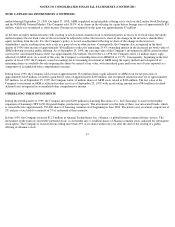Apple 1999 Annual Report Download - page 44
Download and view the complete annual report
Please find page 44 of the 1999 Apple annual report below. You can navigate through the pages in the report by either clicking on the pages listed below, or by using the keyword search tool below to find specific information within the annual report.NOTES TO CONSOLIDATED FINANCIAL STATEMENTS (CONTINUED)
NOTE 1--SUMMARY OF SIGNIFICANT ACCOUNTING POLICIES (CONTINUED)
REVENUE RECOGNITION
The Company recognizes revenue at the time products are shipped. Provisions are made currently for estimated product returns, price
protection, rebates, and other sales programs. Historically, actual amounts recorded for product returns and price protection have not varied
significantly from estimated amounts. During 1999, the Company adopted the American Institute of Certified Public Accountants (AICPA)
Statement of Position (SOP) 97-2, "Software Revenue Recognition," as modified by SOP 98-9, "Modification of SOP 97-2 With Respect to
Certain Transactions". SOP 97-2 establishes standards relating to the recognition of software revenue. SOP 97-2 was effective for transactions
entered into by the Company beginning in the first quarter of fiscal 1999. The adoption of SOP 97-2 did not have a material impact on the
Company's results of operations.
WARRANTY EXPENSE
The Company provides currently for the estimated cost that may be incurred under product warranties when products are shipped.
ADVERTISING COSTS
Advertising costs are charged to expense the first time the advertising takes place. Advertising expense was $208 million, $152 million, and
$143 million for 1999, 1998, and 1997, respectively.
RESEARCH AND DEVELOPMENT
Research and development costs are expensed as incurred. Statement of Financial Accounting Standards (SFAS) No. 86, "Accounting for the
Costs of Computer Software to Be Sold, Leased, or Otherwise Marketed," has not materially affected the Company.
EMPLOYEE SAVINGS PLAN
The Company has an employee savings plan (the Savings Plan) qualifying as a deferred salary arrangement under Section 401(k) of the
Internal Revenue Code. Under the Savings Plan, participating U.S. employees may defer a portion of their pre-tax earnings, up to the Internal
Revenue Service annual contribution limit ($10,000 for calendar year 1999). The Company matches 50% to 100% of each employee's
contributions, depending on length of service, up to a maximum 6% of the employee's earnings. The Company's matching contributions to the
Savings Plan were approximately $13 million, $14 million, and $19 million in 1999, 1998, and 1997, respectively.
EARNINGS (LOSS) PER SHARE
Basic earnings (loss) per common share is computed by dividing income available to common shareholders by the weighted-
average number of
shares of common stock outstanding during the period. Diluted earnings (loss) per common share is computed by dividing income available to
common shareholders by the weighted-average number of shares of common stock outstanding during the period increased to include the
number of additional shares of common stock that would have been outstanding if the dilutive potential shares of common stock had been
issued. The dilutive effect of outstanding options is reflected in diluted earnings per share by application of the treasury stock method. The
dilutive effect of convertible securities is reflected using the if-converted method.
40
























